Strategic Brand Management: A Study of House of Tides Restaurant
VerifiedAdded on 2023/04/23
|21
|6602
|334
Essay
AI Summary
This essay explores the critical aspects of brand management and its impact on consumer behavior, focusing on the case study of House of Tides restaurant. It highlights the increasing importance of brand awareness and image in the competitive fast-food service sector, particularly with changing customer lifestyles. The essay reviews literature on brand equity, communication strategies, brand reputation, and the impact of brand name on consumer purchasing decisions. It emphasizes the need for House of Tides to develop a well-defined branding strategy to enhance its market position and competitive advantage. The analysis also covers how factors like communication, reputation, and brand name influence consumer perceptions and loyalty in the restaurant industry. Desklib offers a range of similar solved assignments and study resources for students.
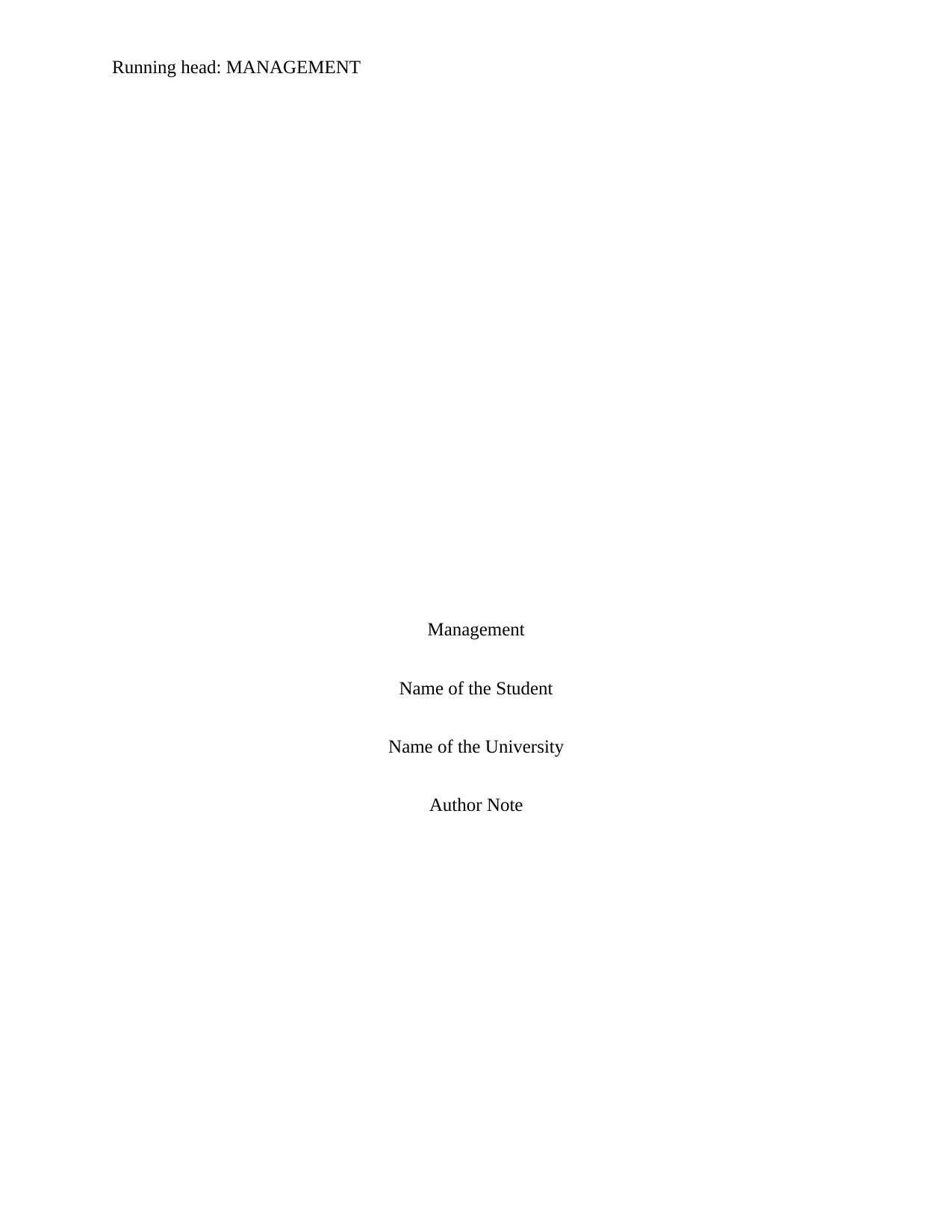
Running head: MANAGEMENT
Management
Name of the Student
Name of the University
Author Note
Management
Name of the Student
Name of the University
Author Note
Paraphrase This Document
Need a fresh take? Get an instant paraphrase of this document with our AI Paraphraser
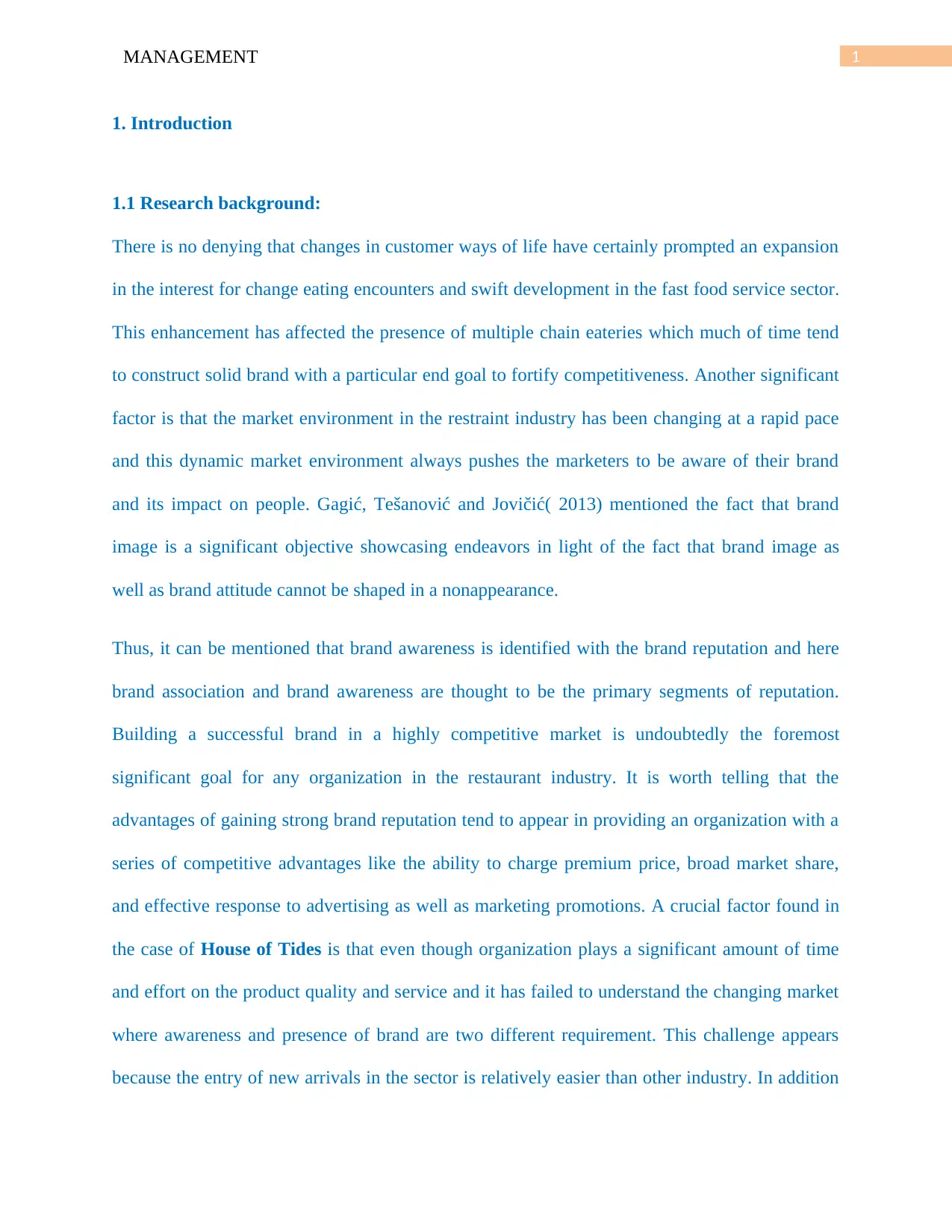
1MANAGEMENT
1. Introduction
1.1 Research background:
There is no denying that changes in customer ways of life have certainly prompted an expansion
in the interest for change eating encounters and swift development in the fast food service sector.
This enhancement has affected the presence of multiple chain eateries which much of time tend
to construct solid brand with a particular end goal to fortify competitiveness. Another significant
factor is that the market environment in the restraint industry has been changing at a rapid pace
and this dynamic market environment always pushes the marketers to be aware of their brand
and its impact on people. Gagić, Tešanović and Jovičić( 2013) mentioned the fact that brand
image is a significant objective showcasing endeavors in light of the fact that brand image as
well as brand attitude cannot be shaped in a nonappearance.
Thus, it can be mentioned that brand awareness is identified with the brand reputation and here
brand association and brand awareness are thought to be the primary segments of reputation.
Building a successful brand in a highly competitive market is undoubtedly the foremost
significant goal for any organization in the restaurant industry. It is worth telling that the
advantages of gaining strong brand reputation tend to appear in providing an organization with a
series of competitive advantages like the ability to charge premium price, broad market share,
and effective response to advertising as well as marketing promotions. A crucial factor found in
the case of House of Tides is that even though organization plays a significant amount of time
and effort on the product quality and service and it has failed to understand the changing market
where awareness and presence of brand are two different requirement. This challenge appears
because the entry of new arrivals in the sector is relatively easier than other industry. In addition
1. Introduction
1.1 Research background:
There is no denying that changes in customer ways of life have certainly prompted an expansion
in the interest for change eating encounters and swift development in the fast food service sector.
This enhancement has affected the presence of multiple chain eateries which much of time tend
to construct solid brand with a particular end goal to fortify competitiveness. Another significant
factor is that the market environment in the restraint industry has been changing at a rapid pace
and this dynamic market environment always pushes the marketers to be aware of their brand
and its impact on people. Gagić, Tešanović and Jovičić( 2013) mentioned the fact that brand
image is a significant objective showcasing endeavors in light of the fact that brand image as
well as brand attitude cannot be shaped in a nonappearance.
Thus, it can be mentioned that brand awareness is identified with the brand reputation and here
brand association and brand awareness are thought to be the primary segments of reputation.
Building a successful brand in a highly competitive market is undoubtedly the foremost
significant goal for any organization in the restaurant industry. It is worth telling that the
advantages of gaining strong brand reputation tend to appear in providing an organization with a
series of competitive advantages like the ability to charge premium price, broad market share,
and effective response to advertising as well as marketing promotions. A crucial factor found in
the case of House of Tides is that even though organization plays a significant amount of time
and effort on the product quality and service and it has failed to understand the changing market
where awareness and presence of brand are two different requirement. This challenge appears
because the entry of new arrivals in the sector is relatively easier than other industry. In addition
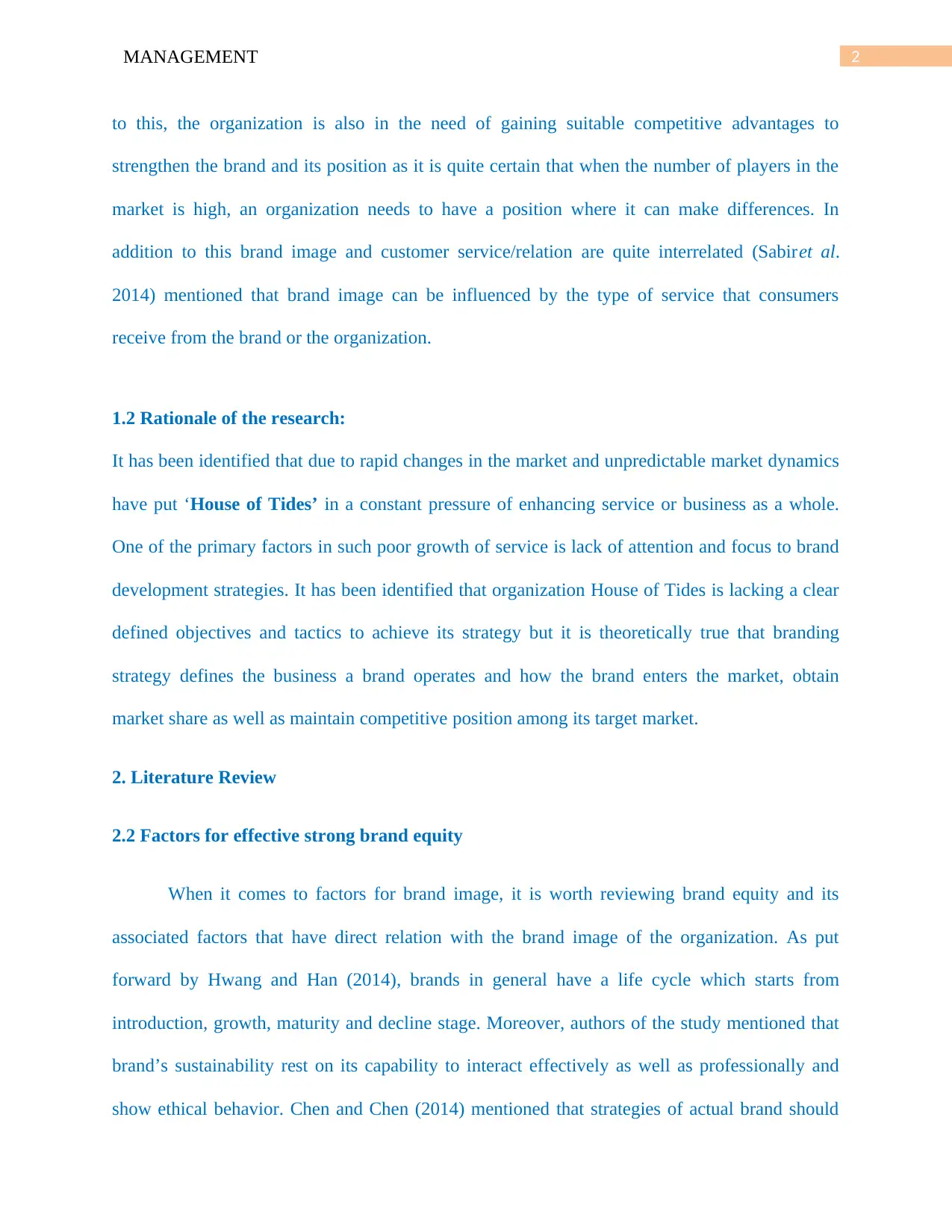
2MANAGEMENT
to this, the organization is also in the need of gaining suitable competitive advantages to
strengthen the brand and its position as it is quite certain that when the number of players in the
market is high, an organization needs to have a position where it can make differences. In
addition to this brand image and customer service/relation are quite interrelated (Sabiret al.
2014) mentioned that brand image can be influenced by the type of service that consumers
receive from the brand or the organization.
1.2 Rationale of the research:
It has been identified that due to rapid changes in the market and unpredictable market dynamics
have put ‘House of Tides’ in a constant pressure of enhancing service or business as a whole.
One of the primary factors in such poor growth of service is lack of attention and focus to brand
development strategies. It has been identified that organization House of Tides is lacking a clear
defined objectives and tactics to achieve its strategy but it is theoretically true that branding
strategy defines the business a brand operates and how the brand enters the market, obtain
market share as well as maintain competitive position among its target market.
2. Literature Review
2.2 Factors for effective strong brand equity
When it comes to factors for brand image, it is worth reviewing brand equity and its
associated factors that have direct relation with the brand image of the organization. As put
forward by Hwang and Han (2014), brands in general have a life cycle which starts from
introduction, growth, maturity and decline stage. Moreover, authors of the study mentioned that
brand’s sustainability rest on its capability to interact effectively as well as professionally and
show ethical behavior. Chen and Chen (2014) mentioned that strategies of actual brand should
to this, the organization is also in the need of gaining suitable competitive advantages to
strengthen the brand and its position as it is quite certain that when the number of players in the
market is high, an organization needs to have a position where it can make differences. In
addition to this brand image and customer service/relation are quite interrelated (Sabiret al.
2014) mentioned that brand image can be influenced by the type of service that consumers
receive from the brand or the organization.
1.2 Rationale of the research:
It has been identified that due to rapid changes in the market and unpredictable market dynamics
have put ‘House of Tides’ in a constant pressure of enhancing service or business as a whole.
One of the primary factors in such poor growth of service is lack of attention and focus to brand
development strategies. It has been identified that organization House of Tides is lacking a clear
defined objectives and tactics to achieve its strategy but it is theoretically true that branding
strategy defines the business a brand operates and how the brand enters the market, obtain
market share as well as maintain competitive position among its target market.
2. Literature Review
2.2 Factors for effective strong brand equity
When it comes to factors for brand image, it is worth reviewing brand equity and its
associated factors that have direct relation with the brand image of the organization. As put
forward by Hwang and Han (2014), brands in general have a life cycle which starts from
introduction, growth, maturity and decline stage. Moreover, authors of the study mentioned that
brand’s sustainability rest on its capability to interact effectively as well as professionally and
show ethical behavior. Chen and Chen (2014) mentioned that strategies of actual brand should
⊘ This is a preview!⊘
Do you want full access?
Subscribe today to unlock all pages.

Trusted by 1+ million students worldwide
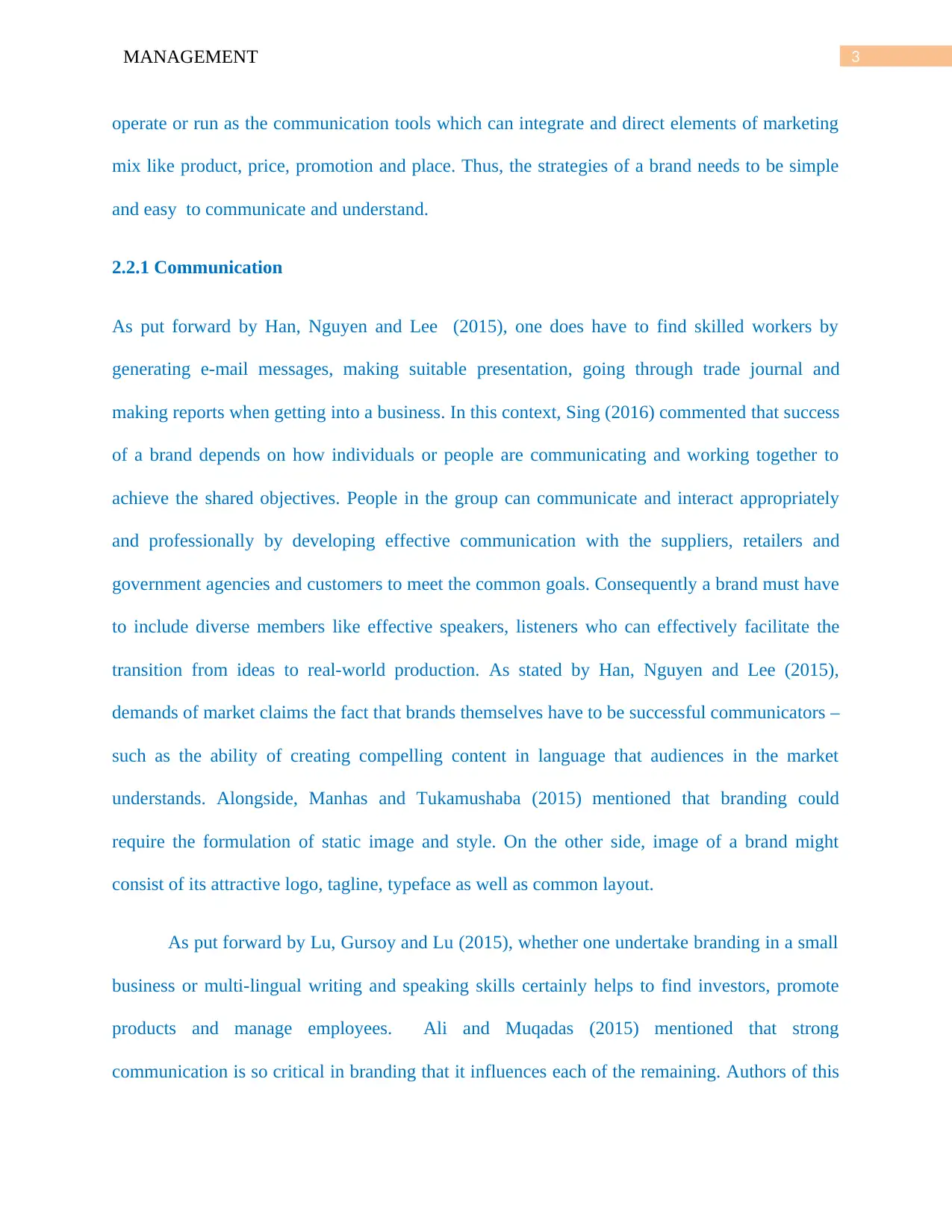
3MANAGEMENT
operate or run as the communication tools which can integrate and direct elements of marketing
mix like product, price, promotion and place. Thus, the strategies of a brand needs to be simple
and easy to communicate and understand.
2.2.1 Communication
As put forward by Han, Nguyen and Lee (2015), one does have to find skilled workers by
generating e-mail messages, making suitable presentation, going through trade journal and
making reports when getting into a business. In this context, Sing (2016) commented that success
of a brand depends on how individuals or people are communicating and working together to
achieve the shared objectives. People in the group can communicate and interact appropriately
and professionally by developing effective communication with the suppliers, retailers and
government agencies and customers to meet the common goals. Consequently a brand must have
to include diverse members like effective speakers, listeners who can effectively facilitate the
transition from ideas to real-world production. As stated by Han, Nguyen and Lee (2015),
demands of market claims the fact that brands themselves have to be successful communicators –
such as the ability of creating compelling content in language that audiences in the market
understands. Alongside, Manhas and Tukamushaba (2015) mentioned that branding could
require the formulation of static image and style. On the other side, image of a brand might
consist of its attractive logo, tagline, typeface as well as common layout.
As put forward by Lu, Gursoy and Lu (2015), whether one undertake branding in a small
business or multi-lingual writing and speaking skills certainly helps to find investors, promote
products and manage employees. Ali and Muqadas (2015) mentioned that strong
communication is so critical in branding that it influences each of the remaining. Authors of this
operate or run as the communication tools which can integrate and direct elements of marketing
mix like product, price, promotion and place. Thus, the strategies of a brand needs to be simple
and easy to communicate and understand.
2.2.1 Communication
As put forward by Han, Nguyen and Lee (2015), one does have to find skilled workers by
generating e-mail messages, making suitable presentation, going through trade journal and
making reports when getting into a business. In this context, Sing (2016) commented that success
of a brand depends on how individuals or people are communicating and working together to
achieve the shared objectives. People in the group can communicate and interact appropriately
and professionally by developing effective communication with the suppliers, retailers and
government agencies and customers to meet the common goals. Consequently a brand must have
to include diverse members like effective speakers, listeners who can effectively facilitate the
transition from ideas to real-world production. As stated by Han, Nguyen and Lee (2015),
demands of market claims the fact that brands themselves have to be successful communicators –
such as the ability of creating compelling content in language that audiences in the market
understands. Alongside, Manhas and Tukamushaba (2015) mentioned that branding could
require the formulation of static image and style. On the other side, image of a brand might
consist of its attractive logo, tagline, typeface as well as common layout.
As put forward by Lu, Gursoy and Lu (2015), whether one undertake branding in a small
business or multi-lingual writing and speaking skills certainly helps to find investors, promote
products and manage employees. Ali and Muqadas (2015) mentioned that strong
communication is so critical in branding that it influences each of the remaining. Authors of this
Paraphrase This Document
Need a fresh take? Get an instant paraphrase of this document with our AI Paraphraser
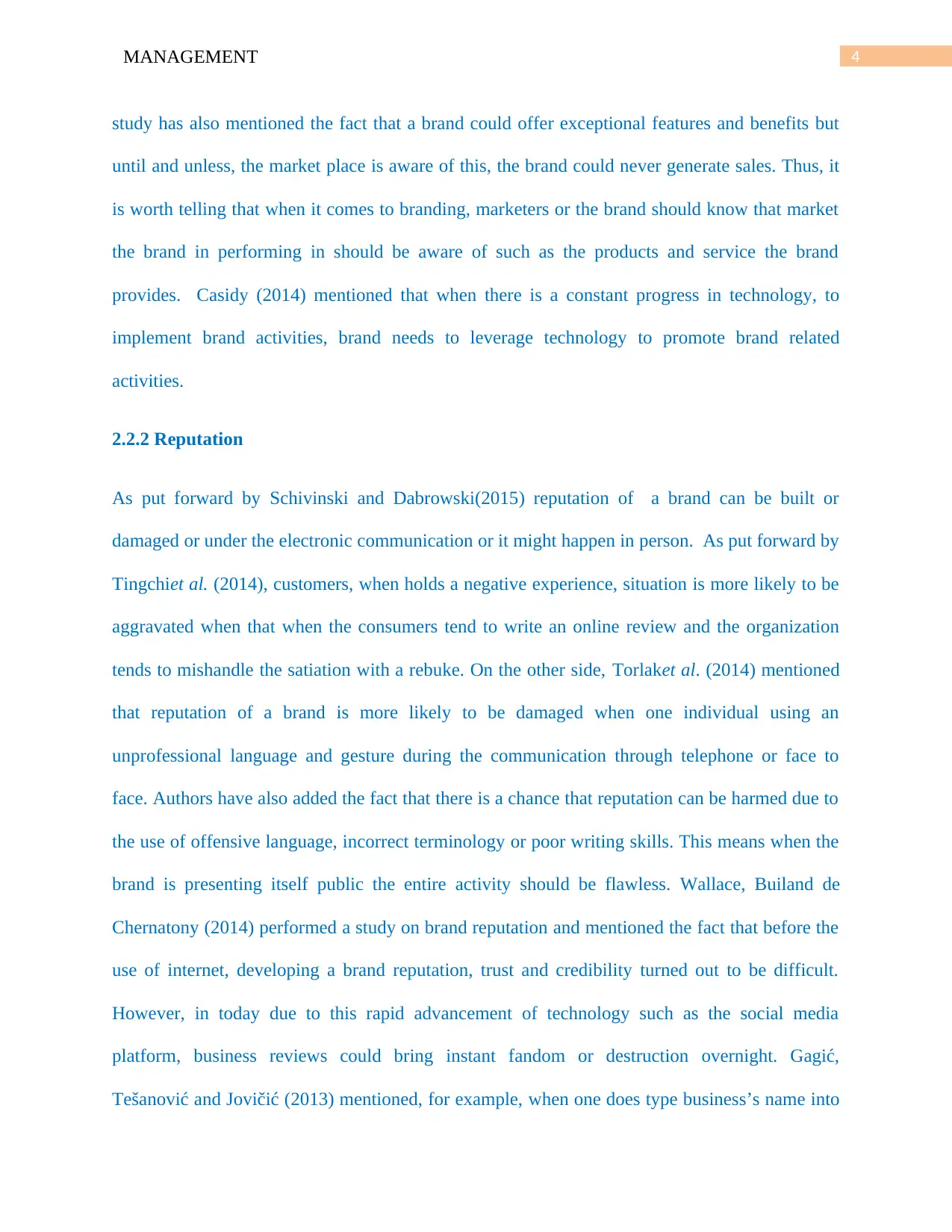
4MANAGEMENT
study has also mentioned the fact that a brand could offer exceptional features and benefits but
until and unless, the market place is aware of this, the brand could never generate sales. Thus, it
is worth telling that when it comes to branding, marketers or the brand should know that market
the brand in performing in should be aware of such as the products and service the brand
provides. Casidy (2014) mentioned that when there is a constant progress in technology, to
implement brand activities, brand needs to leverage technology to promote brand related
activities.
2.2.2 Reputation
As put forward by Schivinski and Dabrowski(2015) reputation of a brand can be built or
damaged or under the electronic communication or it might happen in person. As put forward by
Tingchiet al. (2014), customers, when holds a negative experience, situation is more likely to be
aggravated when that when the consumers tend to write an online review and the organization
tends to mishandle the satiation with a rebuke. On the other side, Torlaket al. (2014) mentioned
that reputation of a brand is more likely to be damaged when one individual using an
unprofessional language and gesture during the communication through telephone or face to
face. Authors have also added the fact that there is a chance that reputation can be harmed due to
the use of offensive language, incorrect terminology or poor writing skills. This means when the
brand is presenting itself public the entire activity should be flawless. Wallace, Builand de
Chernatony (2014) performed a study on brand reputation and mentioned the fact that before the
use of internet, developing a brand reputation, trust and credibility turned out to be difficult.
However, in today due to this rapid advancement of technology such as the social media
platform, business reviews could bring instant fandom or destruction overnight. Gagić,
Tešanović and Jovičić (2013) mentioned, for example, when one does type business’s name into
study has also mentioned the fact that a brand could offer exceptional features and benefits but
until and unless, the market place is aware of this, the brand could never generate sales. Thus, it
is worth telling that when it comes to branding, marketers or the brand should know that market
the brand in performing in should be aware of such as the products and service the brand
provides. Casidy (2014) mentioned that when there is a constant progress in technology, to
implement brand activities, brand needs to leverage technology to promote brand related
activities.
2.2.2 Reputation
As put forward by Schivinski and Dabrowski(2015) reputation of a brand can be built or
damaged or under the electronic communication or it might happen in person. As put forward by
Tingchiet al. (2014), customers, when holds a negative experience, situation is more likely to be
aggravated when that when the consumers tend to write an online review and the organization
tends to mishandle the satiation with a rebuke. On the other side, Torlaket al. (2014) mentioned
that reputation of a brand is more likely to be damaged when one individual using an
unprofessional language and gesture during the communication through telephone or face to
face. Authors have also added the fact that there is a chance that reputation can be harmed due to
the use of offensive language, incorrect terminology or poor writing skills. This means when the
brand is presenting itself public the entire activity should be flawless. Wallace, Builand de
Chernatony (2014) performed a study on brand reputation and mentioned the fact that before the
use of internet, developing a brand reputation, trust and credibility turned out to be difficult.
However, in today due to this rapid advancement of technology such as the social media
platform, business reviews could bring instant fandom or destruction overnight. Gagić,
Tešanović and Jovičić (2013) mentioned, for example, when one does type business’s name into
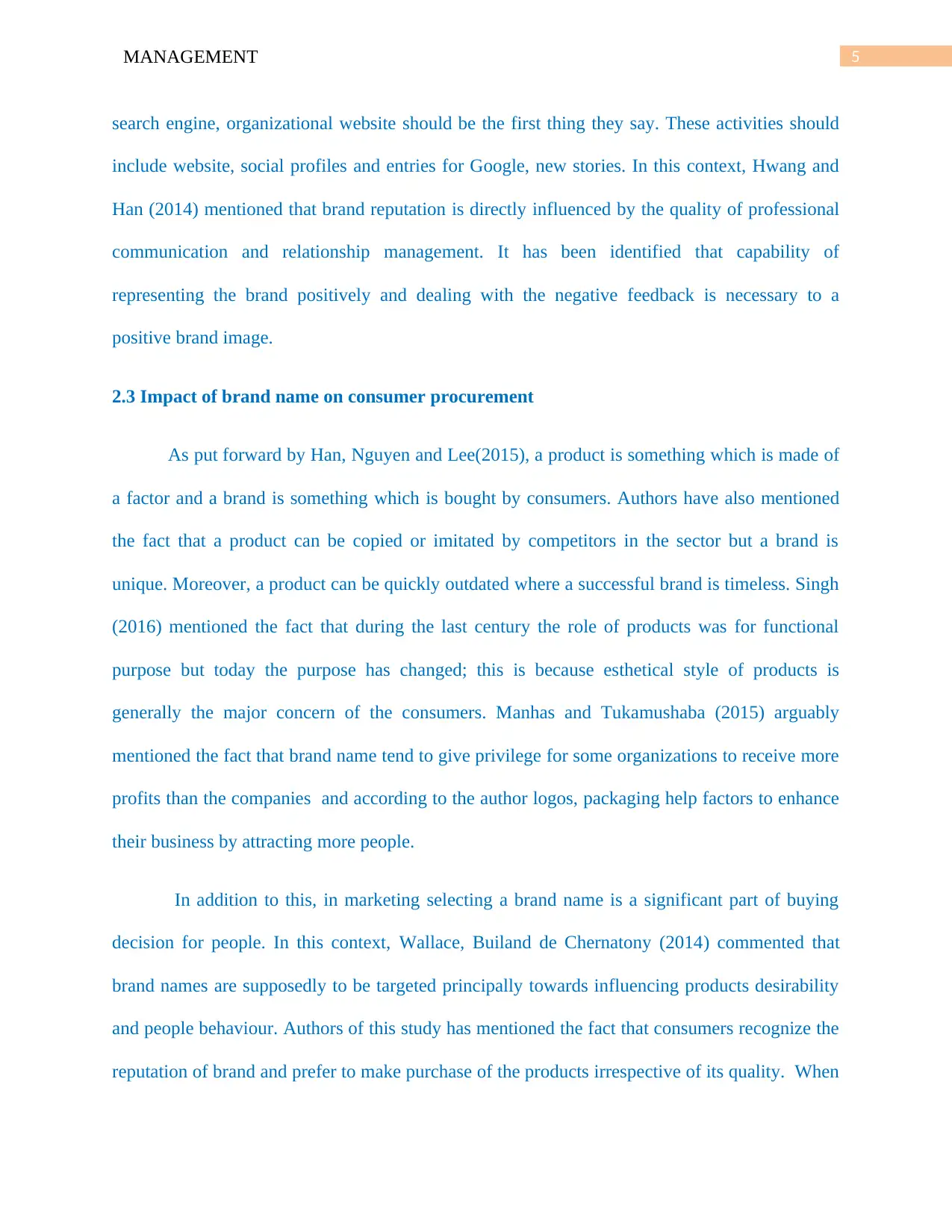
5MANAGEMENT
search engine, organizational website should be the first thing they say. These activities should
include website, social profiles and entries for Google, new stories. In this context, Hwang and
Han (2014) mentioned that brand reputation is directly influenced by the quality of professional
communication and relationship management. It has been identified that capability of
representing the brand positively and dealing with the negative feedback is necessary to a
positive brand image.
2.3 Impact of brand name on consumer procurement
As put forward by Han, Nguyen and Lee(2015), a product is something which is made of
a factor and a brand is something which is bought by consumers. Authors have also mentioned
the fact that a product can be copied or imitated by competitors in the sector but a brand is
unique. Moreover, a product can be quickly outdated where a successful brand is timeless. Singh
(2016) mentioned the fact that during the last century the role of products was for functional
purpose but today the purpose has changed; this is because esthetical style of products is
generally the major concern of the consumers. Manhas and Tukamushaba (2015) arguably
mentioned the fact that brand name tend to give privilege for some organizations to receive more
profits than the companies and according to the author logos, packaging help factors to enhance
their business by attracting more people.
In addition to this, in marketing selecting a brand name is a significant part of buying
decision for people. In this context, Wallace, Builand de Chernatony (2014) commented that
brand names are supposedly to be targeted principally towards influencing products desirability
and people behaviour. Authors of this study has mentioned the fact that consumers recognize the
reputation of brand and prefer to make purchase of the products irrespective of its quality. When
search engine, organizational website should be the first thing they say. These activities should
include website, social profiles and entries for Google, new stories. In this context, Hwang and
Han (2014) mentioned that brand reputation is directly influenced by the quality of professional
communication and relationship management. It has been identified that capability of
representing the brand positively and dealing with the negative feedback is necessary to a
positive brand image.
2.3 Impact of brand name on consumer procurement
As put forward by Han, Nguyen and Lee(2015), a product is something which is made of
a factor and a brand is something which is bought by consumers. Authors have also mentioned
the fact that a product can be copied or imitated by competitors in the sector but a brand is
unique. Moreover, a product can be quickly outdated where a successful brand is timeless. Singh
(2016) mentioned the fact that during the last century the role of products was for functional
purpose but today the purpose has changed; this is because esthetical style of products is
generally the major concern of the consumers. Manhas and Tukamushaba (2015) arguably
mentioned the fact that brand name tend to give privilege for some organizations to receive more
profits than the companies and according to the author logos, packaging help factors to enhance
their business by attracting more people.
In addition to this, in marketing selecting a brand name is a significant part of buying
decision for people. In this context, Wallace, Builand de Chernatony (2014) commented that
brand names are supposedly to be targeted principally towards influencing products desirability
and people behaviour. Authors of this study has mentioned the fact that consumers recognize the
reputation of brand and prefer to make purchase of the products irrespective of its quality. When
⊘ This is a preview!⊘
Do you want full access?
Subscribe today to unlock all pages.

Trusted by 1+ million students worldwide
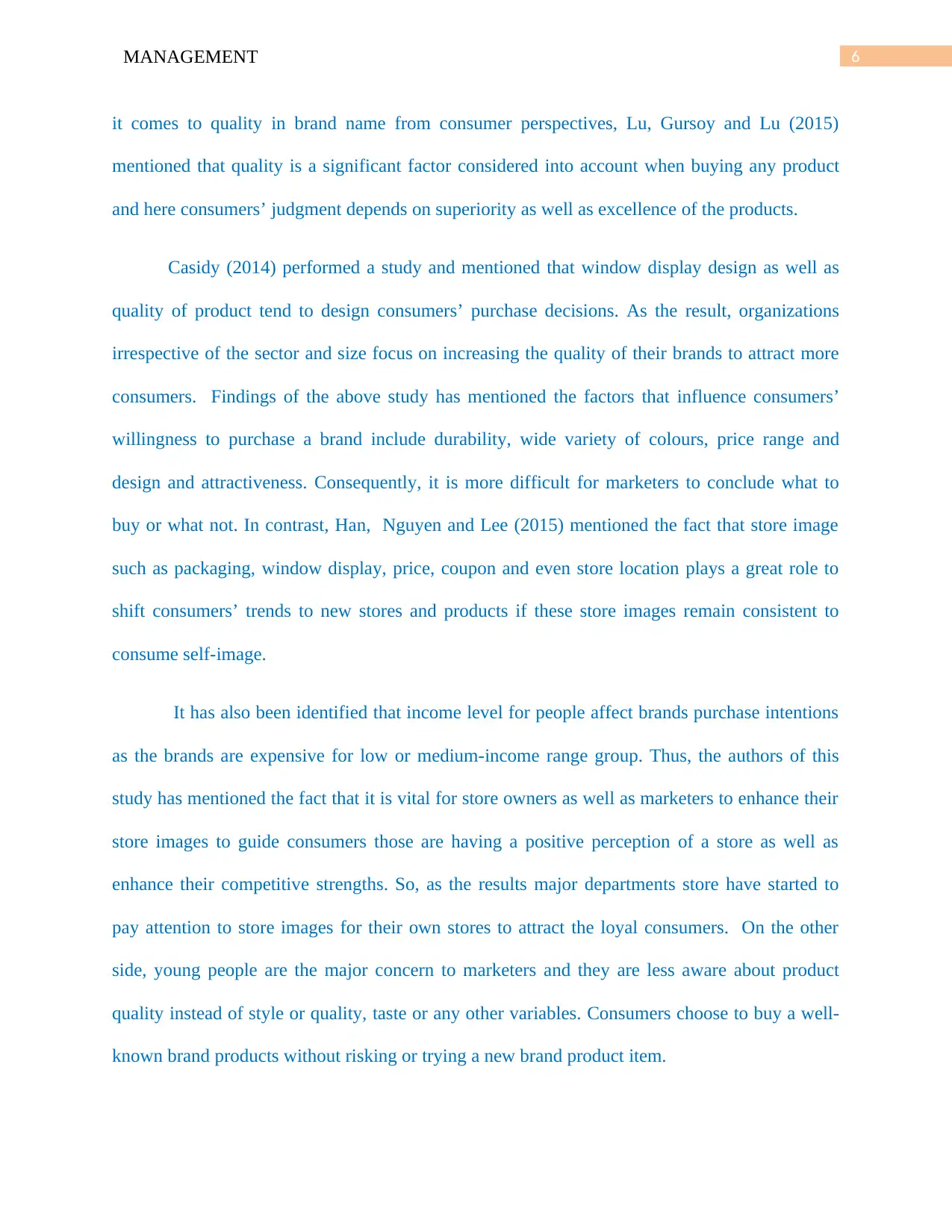
6MANAGEMENT
it comes to quality in brand name from consumer perspectives, Lu, Gursoy and Lu (2015)
mentioned that quality is a significant factor considered into account when buying any product
and here consumers’ judgment depends on superiority as well as excellence of the products.
Casidy (2014) performed a study and mentioned that window display design as well as
quality of product tend to design consumers’ purchase decisions. As the result, organizations
irrespective of the sector and size focus on increasing the quality of their brands to attract more
consumers. Findings of the above study has mentioned the factors that influence consumers’
willingness to purchase a brand include durability, wide variety of colours, price range and
design and attractiveness. Consequently, it is more difficult for marketers to conclude what to
buy or what not. In contrast, Han, Nguyen and Lee (2015) mentioned the fact that store image
such as packaging, window display, price, coupon and even store location plays a great role to
shift consumers’ trends to new stores and products if these store images remain consistent to
consume self-image.
It has also been identified that income level for people affect brands purchase intentions
as the brands are expensive for low or medium-income range group. Thus, the authors of this
study has mentioned the fact that it is vital for store owners as well as marketers to enhance their
store images to guide consumers those are having a positive perception of a store as well as
enhance their competitive strengths. So, as the results major departments store have started to
pay attention to store images for their own stores to attract the loyal consumers. On the other
side, young people are the major concern to marketers and they are less aware about product
quality instead of style or quality, taste or any other variables. Consumers choose to buy a well-
known brand products without risking or trying a new brand product item.
it comes to quality in brand name from consumer perspectives, Lu, Gursoy and Lu (2015)
mentioned that quality is a significant factor considered into account when buying any product
and here consumers’ judgment depends on superiority as well as excellence of the products.
Casidy (2014) performed a study and mentioned that window display design as well as
quality of product tend to design consumers’ purchase decisions. As the result, organizations
irrespective of the sector and size focus on increasing the quality of their brands to attract more
consumers. Findings of the above study has mentioned the factors that influence consumers’
willingness to purchase a brand include durability, wide variety of colours, price range and
design and attractiveness. Consequently, it is more difficult for marketers to conclude what to
buy or what not. In contrast, Han, Nguyen and Lee (2015) mentioned the fact that store image
such as packaging, window display, price, coupon and even store location plays a great role to
shift consumers’ trends to new stores and products if these store images remain consistent to
consume self-image.
It has also been identified that income level for people affect brands purchase intentions
as the brands are expensive for low or medium-income range group. Thus, the authors of this
study has mentioned the fact that it is vital for store owners as well as marketers to enhance their
store images to guide consumers those are having a positive perception of a store as well as
enhance their competitive strengths. So, as the results major departments store have started to
pay attention to store images for their own stores to attract the loyal consumers. On the other
side, young people are the major concern to marketers and they are less aware about product
quality instead of style or quality, taste or any other variables. Consumers choose to buy a well-
known brand products without risking or trying a new brand product item.
Paraphrase This Document
Need a fresh take? Get an instant paraphrase of this document with our AI Paraphraser
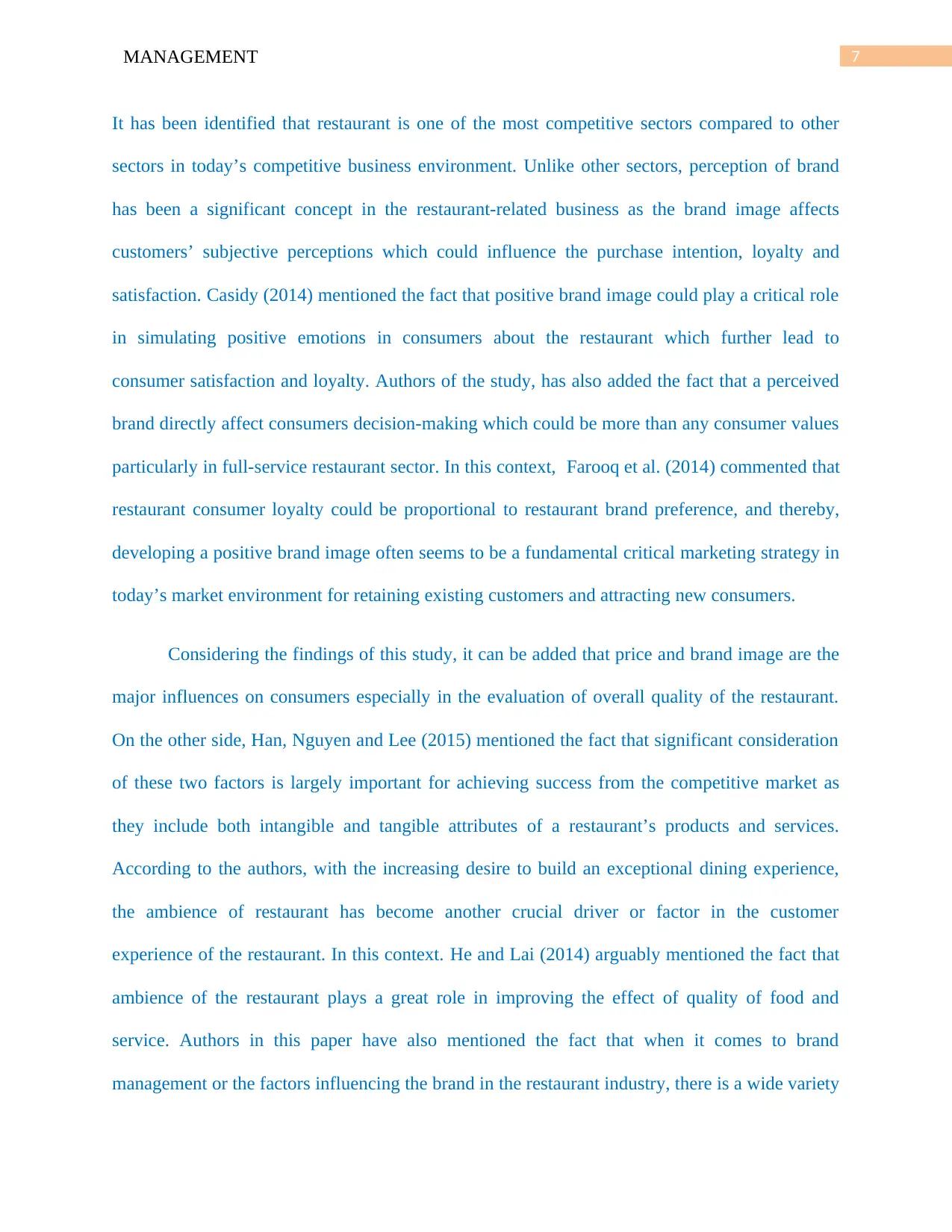
7MANAGEMENT
It has been identified that restaurant is one of the most competitive sectors compared to other
sectors in today’s competitive business environment. Unlike other sectors, perception of brand
has been a significant concept in the restaurant-related business as the brand image affects
customers’ subjective perceptions which could influence the purchase intention, loyalty and
satisfaction. Casidy (2014) mentioned the fact that positive brand image could play a critical role
in simulating positive emotions in consumers about the restaurant which further lead to
consumer satisfaction and loyalty. Authors of the study, has also added the fact that a perceived
brand directly affect consumers decision-making which could be more than any consumer values
particularly in full-service restaurant sector. In this context, Farooq et al. (2014) commented that
restaurant consumer loyalty could be proportional to restaurant brand preference, and thereby,
developing a positive brand image often seems to be a fundamental critical marketing strategy in
today’s market environment for retaining existing customers and attracting new consumers.
Considering the findings of this study, it can be added that price and brand image are the
major influences on consumers especially in the evaluation of overall quality of the restaurant.
On the other side, Han, Nguyen and Lee (2015) mentioned the fact that significant consideration
of these two factors is largely important for achieving success from the competitive market as
they include both intangible and tangible attributes of a restaurant’s products and services.
According to the authors, with the increasing desire to build an exceptional dining experience,
the ambience of restaurant has become another crucial driver or factor in the customer
experience of the restaurant. In this context. He and Lai (2014) arguably mentioned the fact that
ambience of the restaurant plays a great role in improving the effect of quality of food and
service. Authors in this paper have also mentioned the fact that when it comes to brand
management or the factors influencing the brand in the restaurant industry, there is a wide variety
It has been identified that restaurant is one of the most competitive sectors compared to other
sectors in today’s competitive business environment. Unlike other sectors, perception of brand
has been a significant concept in the restaurant-related business as the brand image affects
customers’ subjective perceptions which could influence the purchase intention, loyalty and
satisfaction. Casidy (2014) mentioned the fact that positive brand image could play a critical role
in simulating positive emotions in consumers about the restaurant which further lead to
consumer satisfaction and loyalty. Authors of the study, has also added the fact that a perceived
brand directly affect consumers decision-making which could be more than any consumer values
particularly in full-service restaurant sector. In this context, Farooq et al. (2014) commented that
restaurant consumer loyalty could be proportional to restaurant brand preference, and thereby,
developing a positive brand image often seems to be a fundamental critical marketing strategy in
today’s market environment for retaining existing customers and attracting new consumers.
Considering the findings of this study, it can be added that price and brand image are the
major influences on consumers especially in the evaluation of overall quality of the restaurant.
On the other side, Han, Nguyen and Lee (2015) mentioned the fact that significant consideration
of these two factors is largely important for achieving success from the competitive market as
they include both intangible and tangible attributes of a restaurant’s products and services.
According to the authors, with the increasing desire to build an exceptional dining experience,
the ambience of restaurant has become another crucial driver or factor in the customer
experience of the restaurant. In this context. He and Lai (2014) arguably mentioned the fact that
ambience of the restaurant plays a great role in improving the effect of quality of food and
service. Authors in this paper have also mentioned the fact that when it comes to brand
management or the factors influencing the brand in the restaurant industry, there is a wide variety
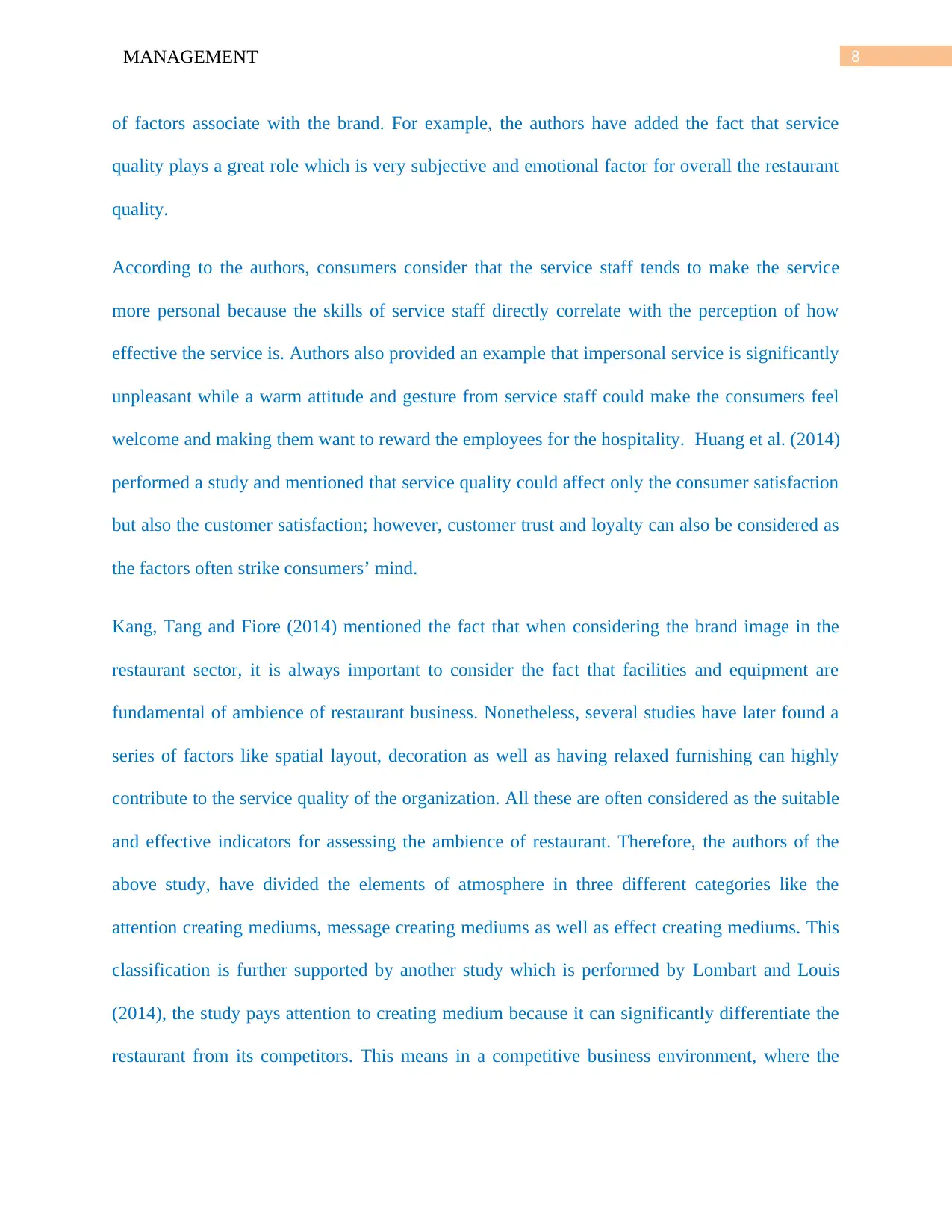
8MANAGEMENT
of factors associate with the brand. For example, the authors have added the fact that service
quality plays a great role which is very subjective and emotional factor for overall the restaurant
quality.
According to the authors, consumers consider that the service staff tends to make the service
more personal because the skills of service staff directly correlate with the perception of how
effective the service is. Authors also provided an example that impersonal service is significantly
unpleasant while a warm attitude and gesture from service staff could make the consumers feel
welcome and making them want to reward the employees for the hospitality. Huang et al. (2014)
performed a study and mentioned that service quality could affect only the consumer satisfaction
but also the customer satisfaction; however, customer trust and loyalty can also be considered as
the factors often strike consumers’ mind.
Kang, Tang and Fiore (2014) mentioned the fact that when considering the brand image in the
restaurant sector, it is always important to consider the fact that facilities and equipment are
fundamental of ambience of restaurant business. Nonetheless, several studies have later found a
series of factors like spatial layout, decoration as well as having relaxed furnishing can highly
contribute to the service quality of the organization. All these are often considered as the suitable
and effective indicators for assessing the ambience of restaurant. Therefore, the authors of the
above study, have divided the elements of atmosphere in three different categories like the
attention creating mediums, message creating mediums as well as effect creating mediums. This
classification is further supported by another study which is performed by Lombart and Louis
(2014), the study pays attention to creating medium because it can significantly differentiate the
restaurant from its competitors. This means in a competitive business environment, where the
of factors associate with the brand. For example, the authors have added the fact that service
quality plays a great role which is very subjective and emotional factor for overall the restaurant
quality.
According to the authors, consumers consider that the service staff tends to make the service
more personal because the skills of service staff directly correlate with the perception of how
effective the service is. Authors also provided an example that impersonal service is significantly
unpleasant while a warm attitude and gesture from service staff could make the consumers feel
welcome and making them want to reward the employees for the hospitality. Huang et al. (2014)
performed a study and mentioned that service quality could affect only the consumer satisfaction
but also the customer satisfaction; however, customer trust and loyalty can also be considered as
the factors often strike consumers’ mind.
Kang, Tang and Fiore (2014) mentioned the fact that when considering the brand image in the
restaurant sector, it is always important to consider the fact that facilities and equipment are
fundamental of ambience of restaurant business. Nonetheless, several studies have later found a
series of factors like spatial layout, decoration as well as having relaxed furnishing can highly
contribute to the service quality of the organization. All these are often considered as the suitable
and effective indicators for assessing the ambience of restaurant. Therefore, the authors of the
above study, have divided the elements of atmosphere in three different categories like the
attention creating mediums, message creating mediums as well as effect creating mediums. This
classification is further supported by another study which is performed by Lombart and Louis
(2014), the study pays attention to creating medium because it can significantly differentiate the
restaurant from its competitors. This means in a competitive business environment, where the
⊘ This is a preview!⊘
Do you want full access?
Subscribe today to unlock all pages.

Trusted by 1+ million students worldwide
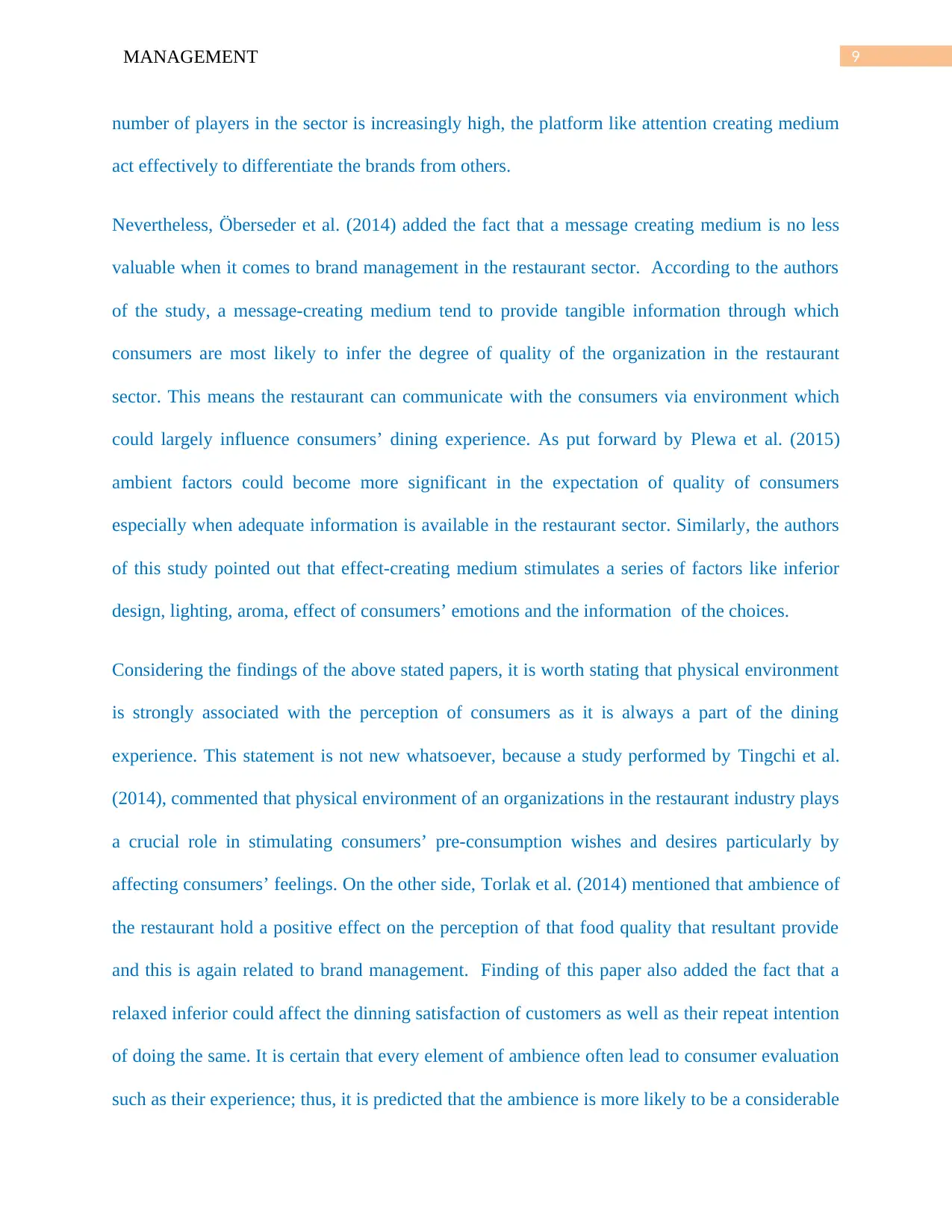
9MANAGEMENT
number of players in the sector is increasingly high, the platform like attention creating medium
act effectively to differentiate the brands from others.
Nevertheless, Öberseder et al. (2014) added the fact that a message creating medium is no less
valuable when it comes to brand management in the restaurant sector. According to the authors
of the study, a message-creating medium tend to provide tangible information through which
consumers are most likely to infer the degree of quality of the organization in the restaurant
sector. This means the restaurant can communicate with the consumers via environment which
could largely influence consumers’ dining experience. As put forward by Plewa et al. (2015)
ambient factors could become more significant in the expectation of quality of consumers
especially when adequate information is available in the restaurant sector. Similarly, the authors
of this study pointed out that effect-creating medium stimulates a series of factors like inferior
design, lighting, aroma, effect of consumers’ emotions and the information of the choices.
Considering the findings of the above stated papers, it is worth stating that physical environment
is strongly associated with the perception of consumers as it is always a part of the dining
experience. This statement is not new whatsoever, because a study performed by Tingchi et al.
(2014), commented that physical environment of an organizations in the restaurant industry plays
a crucial role in stimulating consumers’ pre-consumption wishes and desires particularly by
affecting consumers’ feelings. On the other side, Torlak et al. (2014) mentioned that ambience of
the restaurant hold a positive effect on the perception of that food quality that resultant provide
and this is again related to brand management. Finding of this paper also added the fact that a
relaxed inferior could affect the dinning satisfaction of customers as well as their repeat intention
of doing the same. It is certain that every element of ambience often lead to consumer evaluation
such as their experience; thus, it is predicted that the ambience is more likely to be a considerable
number of players in the sector is increasingly high, the platform like attention creating medium
act effectively to differentiate the brands from others.
Nevertheless, Öberseder et al. (2014) added the fact that a message creating medium is no less
valuable when it comes to brand management in the restaurant sector. According to the authors
of the study, a message-creating medium tend to provide tangible information through which
consumers are most likely to infer the degree of quality of the organization in the restaurant
sector. This means the restaurant can communicate with the consumers via environment which
could largely influence consumers’ dining experience. As put forward by Plewa et al. (2015)
ambient factors could become more significant in the expectation of quality of consumers
especially when adequate information is available in the restaurant sector. Similarly, the authors
of this study pointed out that effect-creating medium stimulates a series of factors like inferior
design, lighting, aroma, effect of consumers’ emotions and the information of the choices.
Considering the findings of the above stated papers, it is worth stating that physical environment
is strongly associated with the perception of consumers as it is always a part of the dining
experience. This statement is not new whatsoever, because a study performed by Tingchi et al.
(2014), commented that physical environment of an organizations in the restaurant industry plays
a crucial role in stimulating consumers’ pre-consumption wishes and desires particularly by
affecting consumers’ feelings. On the other side, Torlak et al. (2014) mentioned that ambience of
the restaurant hold a positive effect on the perception of that food quality that resultant provide
and this is again related to brand management. Finding of this paper also added the fact that a
relaxed inferior could affect the dinning satisfaction of customers as well as their repeat intention
of doing the same. It is certain that every element of ambience often lead to consumer evaluation
such as their experience; thus, it is predicted that the ambience is more likely to be a considerable
Paraphrase This Document
Need a fresh take? Get an instant paraphrase of this document with our AI Paraphraser
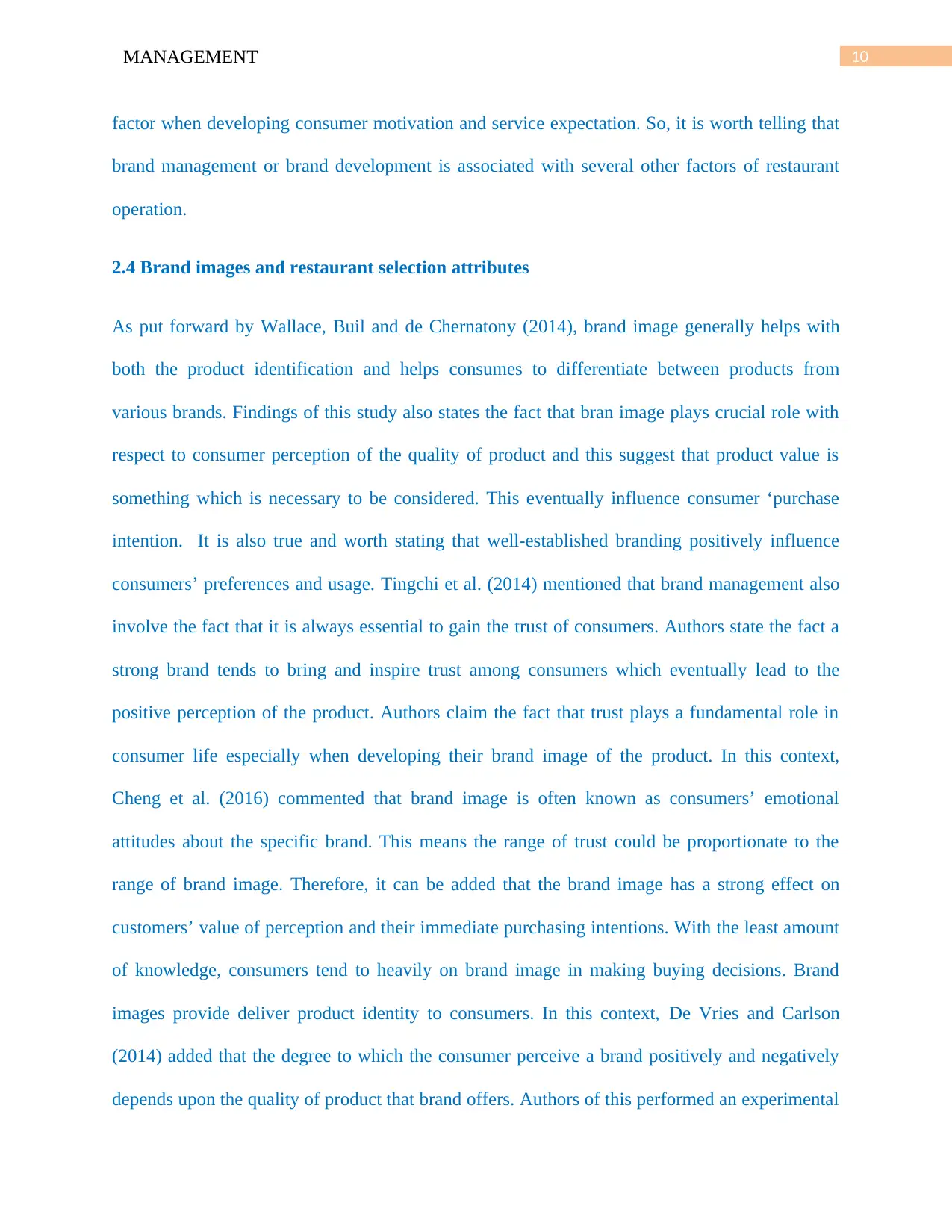
10MANAGEMENT
factor when developing consumer motivation and service expectation. So, it is worth telling that
brand management or brand development is associated with several other factors of restaurant
operation.
2.4 Brand images and restaurant selection attributes
As put forward by Wallace, Buil and de Chernatony (2014), brand image generally helps with
both the product identification and helps consumes to differentiate between products from
various brands. Findings of this study also states the fact that bran image plays crucial role with
respect to consumer perception of the quality of product and this suggest that product value is
something which is necessary to be considered. This eventually influence consumer ‘purchase
intention. It is also true and worth stating that well-established branding positively influence
consumers’ preferences and usage. Tingchi et al. (2014) mentioned that brand management also
involve the fact that it is always essential to gain the trust of consumers. Authors state the fact a
strong brand tends to bring and inspire trust among consumers which eventually lead to the
positive perception of the product. Authors claim the fact that trust plays a fundamental role in
consumer life especially when developing their brand image of the product. In this context,
Cheng et al. (2016) commented that brand image is often known as consumers’ emotional
attitudes about the specific brand. This means the range of trust could be proportionate to the
range of brand image. Therefore, it can be added that the brand image has a strong effect on
customers’ value of perception and their immediate purchasing intentions. With the least amount
of knowledge, consumers tend to heavily on brand image in making buying decisions. Brand
images provide deliver product identity to consumers. In this context, De Vries and Carlson
(2014) added that the degree to which the consumer perceive a brand positively and negatively
depends upon the quality of product that brand offers. Authors of this performed an experimental
factor when developing consumer motivation and service expectation. So, it is worth telling that
brand management or brand development is associated with several other factors of restaurant
operation.
2.4 Brand images and restaurant selection attributes
As put forward by Wallace, Buil and de Chernatony (2014), brand image generally helps with
both the product identification and helps consumes to differentiate between products from
various brands. Findings of this study also states the fact that bran image plays crucial role with
respect to consumer perception of the quality of product and this suggest that product value is
something which is necessary to be considered. This eventually influence consumer ‘purchase
intention. It is also true and worth stating that well-established branding positively influence
consumers’ preferences and usage. Tingchi et al. (2014) mentioned that brand management also
involve the fact that it is always essential to gain the trust of consumers. Authors state the fact a
strong brand tends to bring and inspire trust among consumers which eventually lead to the
positive perception of the product. Authors claim the fact that trust plays a fundamental role in
consumer life especially when developing their brand image of the product. In this context,
Cheng et al. (2016) commented that brand image is often known as consumers’ emotional
attitudes about the specific brand. This means the range of trust could be proportionate to the
range of brand image. Therefore, it can be added that the brand image has a strong effect on
customers’ value of perception and their immediate purchasing intentions. With the least amount
of knowledge, consumers tend to heavily on brand image in making buying decisions. Brand
images provide deliver product identity to consumers. In this context, De Vries and Carlson
(2014) added that the degree to which the consumer perceive a brand positively and negatively
depends upon the quality of product that brand offers. Authors of this performed an experimental
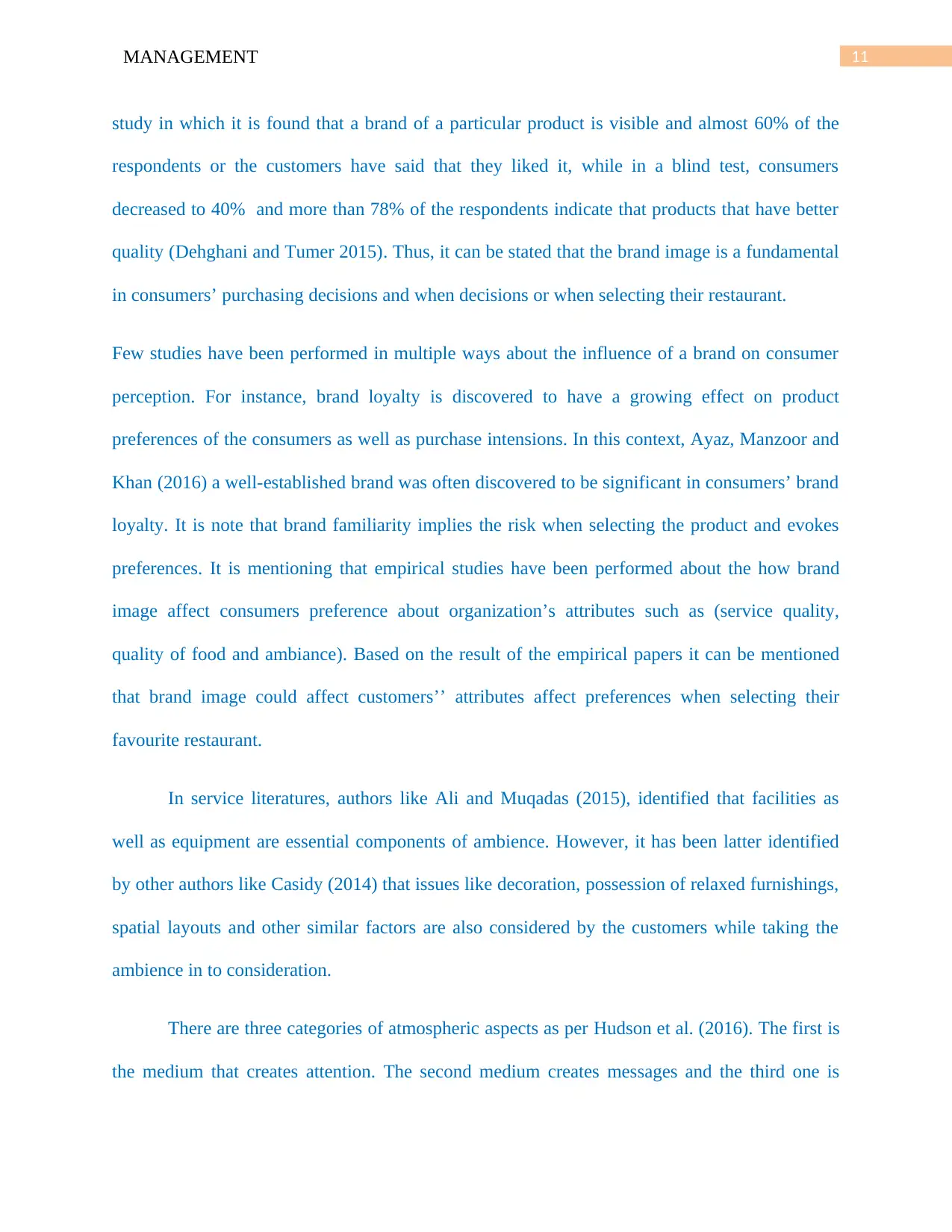
11MANAGEMENT
study in which it is found that a brand of a particular product is visible and almost 60% of the
respondents or the customers have said that they liked it, while in a blind test, consumers
decreased to 40% and more than 78% of the respondents indicate that products that have better
quality (Dehghani and Tumer 2015). Thus, it can be stated that the brand image is a fundamental
in consumers’ purchasing decisions and when decisions or when selecting their restaurant.
Few studies have been performed in multiple ways about the influence of a brand on consumer
perception. For instance, brand loyalty is discovered to have a growing effect on product
preferences of the consumers as well as purchase intensions. In this context, Ayaz, Manzoor and
Khan (2016) a well-established brand was often discovered to be significant in consumers’ brand
loyalty. It is note that brand familiarity implies the risk when selecting the product and evokes
preferences. It is mentioning that empirical studies have been performed about the how brand
image affect consumers preference about organization’s attributes such as (service quality,
quality of food and ambiance). Based on the result of the empirical papers it can be mentioned
that brand image could affect customers’’ attributes affect preferences when selecting their
favourite restaurant.
In service literatures, authors like Ali and Muqadas (2015), identified that facilities as
well as equipment are essential components of ambience. However, it has been latter identified
by other authors like Casidy (2014) that issues like decoration, possession of relaxed furnishings,
spatial layouts and other similar factors are also considered by the customers while taking the
ambience in to consideration.
There are three categories of atmospheric aspects as per Hudson et al. (2016). The first is
the medium that creates attention. The second medium creates messages and the third one is
study in which it is found that a brand of a particular product is visible and almost 60% of the
respondents or the customers have said that they liked it, while in a blind test, consumers
decreased to 40% and more than 78% of the respondents indicate that products that have better
quality (Dehghani and Tumer 2015). Thus, it can be stated that the brand image is a fundamental
in consumers’ purchasing decisions and when decisions or when selecting their restaurant.
Few studies have been performed in multiple ways about the influence of a brand on consumer
perception. For instance, brand loyalty is discovered to have a growing effect on product
preferences of the consumers as well as purchase intensions. In this context, Ayaz, Manzoor and
Khan (2016) a well-established brand was often discovered to be significant in consumers’ brand
loyalty. It is note that brand familiarity implies the risk when selecting the product and evokes
preferences. It is mentioning that empirical studies have been performed about the how brand
image affect consumers preference about organization’s attributes such as (service quality,
quality of food and ambiance). Based on the result of the empirical papers it can be mentioned
that brand image could affect customers’’ attributes affect preferences when selecting their
favourite restaurant.
In service literatures, authors like Ali and Muqadas (2015), identified that facilities as
well as equipment are essential components of ambience. However, it has been latter identified
by other authors like Casidy (2014) that issues like decoration, possession of relaxed furnishings,
spatial layouts and other similar factors are also considered by the customers while taking the
ambience in to consideration.
There are three categories of atmospheric aspects as per Hudson et al. (2016). The first is
the medium that creates attention. The second medium creates messages and the third one is
⊘ This is a preview!⊘
Do you want full access?
Subscribe today to unlock all pages.

Trusted by 1+ million students worldwide
1 out of 21
Related Documents
Your All-in-One AI-Powered Toolkit for Academic Success.
+13062052269
info@desklib.com
Available 24*7 on WhatsApp / Email
![[object Object]](/_next/static/media/star-bottom.7253800d.svg)
Unlock your academic potential
Copyright © 2020–2025 A2Z Services. All Rights Reserved. Developed and managed by ZUCOL.





